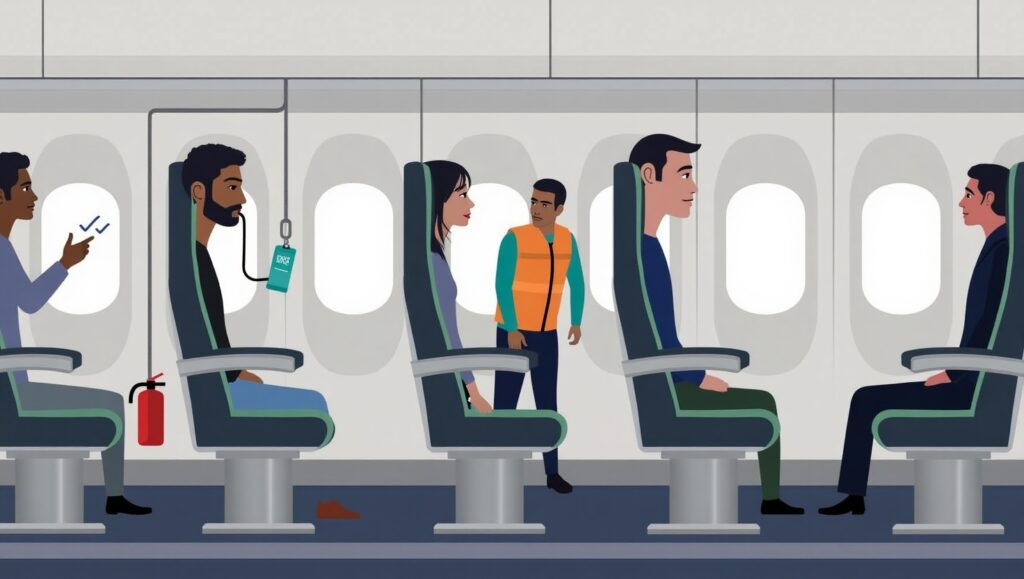When we board an aircraft, most of our attention goes to finding our seat, stowing our luggage, and preparing for takeoff. However, it’s important to recognize the array of safety features quietly working behind the scenes to ensure passenger and crew safety. Modern aircraft come equipped with various advanced safety equipment, each designed with one clear goal: protecting everyone on board.
Seatbelts – A Fundamental Safety Feature
While seatbelts might seem like a simple, everyday safety feature, they are crucial to keeping passengers safe during a flight. In the event of turbulence, takeoffs, or landings, seatbelts prevent passengers from being thrown from their seats, reducing the risk of injury. Unlike car seatbelts, aircraft seatbelts are built to withstand much higher forces, ensuring passengers stay securely in their seats throughout the flight.
Oxygen Masks – Essential for Breathing at High Altitudes
Have you ever noticed the small compartment above your seat? That’s where the oxygen masks are stored. In the rare event of cabin depressurization, these masks automatically deploy, providing passengers with the necessary oxygen to breathe. At high altitudes, the air pressure is significantly lower, and these masks help passengers breathe comfortably until the aircraft descends to a safer, lower altitude. Remember, it’s always important to secure your own mask before assisting others.
Emergency Exit Doors – Quick Evacuation in Case of Emergency
Emergency exits are one of the most prominent safety features on an aircraft. Each plane is equipped with multiple emergency exits, and the cabin crew always highlights their locations during the pre-flight safety briefing. Passengers who are physically able and have consented to assist the crew are seated near these exits to help open the doors in case of an emergency, ensuring a swift evacuation.
Fire Extinguishers and Smoke Detectors – Combating Fire Hazards
Aircraft are equipped with sophisticated fire prevention and suppression systems. Smoke detectors in areas like the lavatories and cargo holds detect potential fires early. Fire extinguishers are strategically placed throughout the cabin and cockpit for easy access. The cabin crew is specially trained to use these extinguishers and handle fire emergencies efficiently.
First Aid Kits and Emergency Medical Equipment – Addressing Health Emergencies
Every aircraft is equipped with a first aid kit that contains essential supplies to treat common medical issues, such as minor injuries or illnesses. Many aircraft are also equipped with Automated External Defibrillators (AEDs) to provide life-saving assistance during cardiac emergencies. Additionally, cabin crew members receive specialized medical training to manage health situations until professional help arrives.
Red and Green Navigation Lights – Ensuring Safe Navigation
Every aircraft is fitted with red and green navigation lights at the tips of the left and right wings, respectively. These lights help pilots determine the direction of other aircraft, particularly during night flights. The navigation lights help prevent mid-air collisions, making them a vital safety feature for air traffic management.
Evacuation Lighting and Markings – Guiding You in the Dark
In an emergency, clear visibility can be a life-saver. Evacuation lighting and floor markings are designed to guide passengers to the nearest exit, even in low-visibility conditions such as smoke or darkness. During the pre-flight safety briefing, passengers are reminded to identify their nearest exits, which may even be behind them.
Black Box Recorders – Enhancing Aviation Safety
Although not a direct safety feature for passengers, the black box plays a key role in aviation safety. Every aircraft is equipped with flight data recorders and cockpit voice recorders, commonly known as black boxes. In the rare event of an accident, these devices provide valuable information that investigators use to understand what happened and improve safety protocols for future flights.
The Hidden Safety Features You Don’t See
In addition to visible safety equipment, modern aircraft are outfitted with a variety of advanced systems that passengers rarely notice. These include weather radars, collision avoidance systems, deicing and anti-icing mechanisms, and state-of-the-art navigation tools. All of these systems work together to help pilots maintain control of the aircraft, even under challenging conditions. Aircraft also undergo rigorous maintenance and regular safety checks to ensure that every flight is as safe as possible.
Conclusion: The Comprehensive Safety Network
The combination of advanced engineering, detailed planning, and comprehensive safety features makes air travel one of the safest modes of transportation. Next time you board a flight, take a moment to appreciate the sophisticated network of systems and equipment that are designed to keep you safe throughout your journey.

